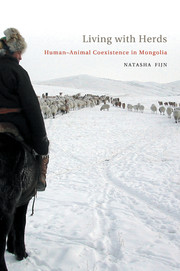Book contents
- Frontmatter
- Contents
- Lists of Plates, Figures, Maps, Tables, and Online Video Segments
- Glossary
- Acknowledgments
- LIVING WITH HERDS
- PART ONE CROSSING BOUNDARIES
- PART TWO THE SOCIAL HERD
- 3 SOCIAL SPHERES
- 4 NAMES, SYMBOLS, COLOURS, AND BREEDING
- 5 MULTISPECIES ENCULTURATION
- 6 TAMENESS AND CONTROL
- PART THREE LIVING WITH HERDS
- Appendix
- References
- Index
- Plate section
5 - MULTISPECIES ENCULTURATION
from PART TWO - THE SOCIAL HERD
Published online by Cambridge University Press: 03 May 2011
- Frontmatter
- Contents
- Lists of Plates, Figures, Maps, Tables, and Online Video Segments
- Glossary
- Acknowledgments
- LIVING WITH HERDS
- PART ONE CROSSING BOUNDARIES
- PART TWO THE SOCIAL HERD
- 3 SOCIAL SPHERES
- 4 NAMES, SYMBOLS, COLOURS, AND BREEDING
- 5 MULTISPECIES ENCULTURATION
- 6 TAMENESS AND CONTROL
- PART THREE LIVING WITH HERDS
- Appendix
- References
- Index
- Plate section
Summary
The most remarkable feature of this kind of interspecies communication between such different kinds of being is that it takes place at all.
(Patton 2003: 88)We are not different from other species by having a culture which they lack; we are different in that our culture, like our shape, is different from theirs.
(Rose 1984: 46)INTRODUCTION
We expect domestic animals to interact with us and to understand our communication with them, even though we are separate species and our evolutionary paths are quite different. Humans and ungulates are able to respond to cues and gestures that are a product of their social gregariousness, engaging in both intraspecies and interspecies communication. Seminal papers on animal communication by Dawkins and Krebs in the late 1970s recognised that animals communicate between species and are even deceitful in their intentions towards one another, particularly between predator and prey (Dawkins 1978; Dawkins & Krebs 1979; Guilford & Dawkins 1991). Dogs, humans, and sheep are able to assist one another in a farming situation through one species communicating signals and another species receiving those signals and reacting to them. As Donna Haraway (2007) points out, the whole process would not work if sheep did not know how to understand dogs and if dogs did not know how to interpret them. In a Western context, cross-species communication between a farmer and a sheep dog may develop into a wide array of voice commands, whistles, and pointing signals.
- Type
- Chapter
- Information
- Living with HerdsHuman-Animal Coexistence in Mongolia, pp. 104 - 128Publisher: Cambridge University PressPrint publication year: 2011



